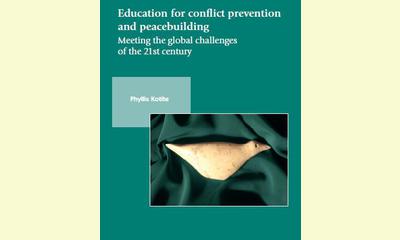|
|
Education for Conflict Prevention and Peacebuilding: Meeting the global challenges of the 21st century
an article by IIEP-UNESCO
This new publication from IIEP and UNESCO on conflict prevention and peacebuilding may be downloaded here.

click on photo to enlarge
Conflicts can have devastating effects on education systems and impair the ability of governments to provide quality education for their citizens. Yet, when governments and ministries of education analyse and anticipate the risk of such events through careful planning, education can play an important role in preventing violent conflict, and in supporting peacebuilding efforts.
The paper describes a range of conflict prevention initiatives and examines the role of policy-makers, youth, women, and the media in maintaining and restoring peace as part of a holistic vision of education. International institutions, governments and civil society are increasingly developing conflict prevention mechanisms and utilizing political and economic incentives to avoid conflicts. The paper argues that educational planning must go beyond traditional mechanisms and take into consideration the unpredictable nature of our times, be flexible and rapid in implementation and responsive to local needs.
Training and research in sustainable development; and skills for peaceful relations, good governance, the prevention of conflict and peacebuilding are among the priorities elaborated in the paper. In addition, specific recommendations are highlighted such as: capacity development for conflict prevention within the education sector and other ministries, analysing the root causes of conflict and the role that education can play in mitigating tensions.
Included are contributions from Federico Mayor, Anwarul Chowdhury, Layashi Yaker, Rima Salah, Betty Reardon and others.
The author, Phyllis Kotite, is an International Consultant and a former staff member of the United Nations at UNESCWA, Beirut. She has worked in: the Cabinet of the Director-General of UNESCO from 1989 to 1991; with the Executive Secretary of UNECA; and was consultant to the Commissioner General of UNRWA. She has also worked for UNEP in the Arab Region, UNICEF in New York, and as consultant to UNDP and other international institutions. She has undertaken missions in over 15 countries, and is the author of over 30 publications, articles and reports.
|








|
DISCUSSION
Question(s) related to this article:
What are the most important books about the culture of peace?,
* * * * *
Latest reader comment:
Johan Galtung is indeed the most perceptive peace researcher of our time.
Not only did he predict the fall of the Soviet Union quite precisely, but he has also predicted the fall of the American empire. Here are excerpts from his 2004 article,
On the Coming Decline and Fall of the US Empire
The prediction of the decline and fall of the US Empire is based on the synergy of 14 contradictions, and the time span for the contradictions to work their way through decline to fall was estimated at 25 years in the year 2000. There are more contradictions because the US Empire is more complex, and the time span is longer also because it is more sophisticated. After the first months of President George W. Bush (selected) the time span was reduced to 20 years because of the way in which he sharpened so many of the contradictions posited the year before, and because his extreme singlemindedness made him blind to the negative, complex synergies. . . .
Here is the list of 14 contradictions posited in 2000:
I. Economic Contradictions(US led system WB/IMF/WTO NYSE Pentagon)
1. between growth and distribution: overproduction relative to demand, 1.4 billion below $ 1/day, 100.000 die/day, 1/4 of hunger
2. between productive and finance economy (currency, stocks,bonds) overvalued, hence crashes, unemployment, contract work
3. between production/distribution/consumption and nature: ecocrisis, depletion/pollution, global warming
II. Military Contradictions (US led system NATO/TIAP/USA-Japan)
4. between US state terrorism and terrorism: Blowback
5. between US and allies (except UK, D, Japan), saying enough
6. between US hegemony in Eurasia and the Russia India China triangle, with 40% of humanity
7. between US led NATO and EU army: The Tindemans follow-up
III. Political Contradictions (US exceptionalism under God)
8. between USA and the UN: The UN hitting back
9. between USA and the EU: vying for Orthodox/Muslim support
IV. Cultural Contradictions (US triumphant plebeian culture)
10. between US Judeo-Christianity and Islam (25% of humanity; UNSC nucleus has four Christian and none of the 56 Muslim countries).
11. between US and the oldest civilizations (Chinese, Indian, Mesopotamian, Aztec/Inca/Maya)
12. between US and European elite culture: France, Germany, etc.
V. Social Contradictions (US led world elites vs the rest: World Economic Forum, Davos vs World Social Forum, Porto Alegre)
13. between state corporate elites and working classes of unemployed and contract workers. The middle classes?
14. between older generation and youth: Seattle, Washington, Praha, Genova and ever younger youth. The middle generation?
15. To this could be added: between myth and reality.

|
|









